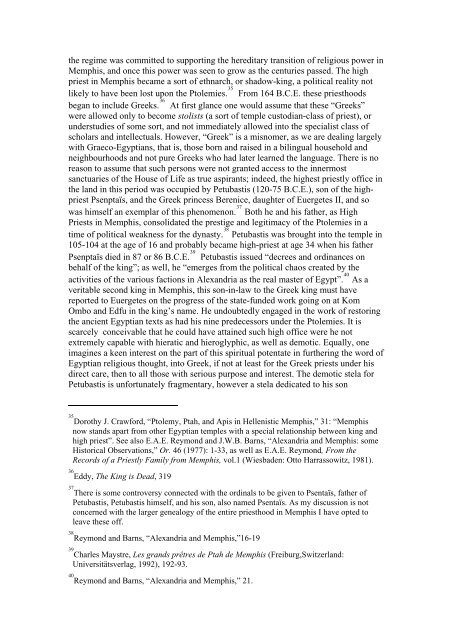THE EGYPTIAN FOUNDATIONS OF GNOSTIC THOUGHT
THE EGYPTIAN FOUNDATIONS OF GNOSTIC THOUGHT
THE EGYPTIAN FOUNDATIONS OF GNOSTIC THOUGHT
You also want an ePaper? Increase the reach of your titles
YUMPU automatically turns print PDFs into web optimized ePapers that Google loves.
the regime was committed to supporting the hereditary transition of religious power in<br />
Memphis, and once this power was seen to grow as the centuries passed. The high<br />
priest in Memphis became a sort of ethnarch, or shadow-king, a political reality not<br />
likely to have been lost upon the Ptolemies. 35<br />
From 164 B.C.E. these priesthoods<br />
began to include Greeks. 36<br />
At first glance one would assume that these “Greeks”<br />
were allowed only to become stolists (a sort of temple custodian-class of priest), or<br />
understudies of some sort, and not immediately allowed into the specialist class of<br />
scholars and intellectuals. However, “Greek” is a misnomer, as we are dealing largely<br />
with Graeco-Egyptians, that is, those born and raised in a bilingual household and<br />
neighbourhoods and not pure Greeks who had later learned the language. There is no<br />
reason to assume that such persons were not granted access to the innermost<br />
sanctuaries of the House of Life as true aspirants; indeed, the highest priestly office in<br />
the land in this period was occupied by Petubastis (120-75 B.C.E.), son of the highpriest<br />
Psenptaïs, and the Greek princess Berenice, daughter of Euergetes II, and so<br />
was himself an exemplar of this phenomenon. 37<br />
Both he and his father, as High<br />
Priests in Memphis, consolidated the prestige and legitimacy of the Ptolemies in a<br />
time of political weakness for the dynasty. 38<br />
Petubastis was brought into the temple in<br />
105-104 at the age of 16 and probably became high-priest at age 34 when his father<br />
Psenptaïs died in 87 or 86 B.C.E. 39<br />
Petubastis issued “decrees and ordinances on<br />
behalf of the king”; as well, he “emerges from the political chaos created by the<br />
activities of the various factions in Alexandria as the real master of Egypt”. 40<br />
As a<br />
veritable second king in Memphis, this son-in-law to the Greek king must have<br />
reported to Euergetes on the progress of the state-funded work going on at Kom<br />
Ombo and Edfu in the king’s name. He undoubtedly engaged in the work of restoring<br />
the ancient Egyptian texts as had his nine predecessors under the Ptolemies. It is<br />
scarcely conceivable that he could have attained such high office were he not<br />
extremely capable with hieratic and hieroglyphic, as well as demotic. Equally, one<br />
imagines a keen interest on the part of this spiritual potentate in furthering the word of<br />
Egyptian religious thought, into Greek, if not at least for the Greek priests under his<br />
direct care, then to all those with serious purpose and interest. The demotic stela for<br />
Petubastis is unfortunately fragmentary, however a stela dedicated to his son<br />
35<br />
Dorothy J. Crawford, “Ptolemy, Ptah, and Apis in Hellenistic Memphis,” 31: “Memphis<br />
now stands apart from other Egyptian temples with a special relationship between king and<br />
high priest”. See also E.A.E. Reymond and J.W.B. Barns, “Alexandria and Memphis: some<br />
Historical Observations,” Or. 46 (1977): 1-33, as well as E.A.E. Reymond, From the<br />
Records of a Priestly Family from Memphis, vol.1 (Wiesbaden: Otto Harrassowitz, 1981).<br />
36<br />
Eddy, The King is Dead, 319<br />
37<br />
There is some controversy connected with the ordinals to be given to Psentaïs, father of<br />
Petubastis, Petubastis himself, and his son, also named Psentaïs. As my discussion is not<br />
concerned with the larger genealogy of the entire priesthood in Memphis I have opted to<br />
leave these off.<br />
38<br />
Reymond and Barns, “Alexandria and Memphis,”16-19<br />
39<br />
Charles Maystre, Les grands prêtres de Ptah de Memphis (Freiburg,Switzerland:<br />
Universitätsverlag, 1992), 192-93.<br />
40<br />
Reymond and Barns, “Alexandria and Memphis,” 21.










